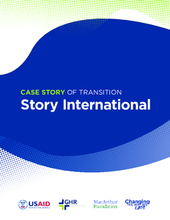The aim of this stage is to identify, locate and establish contact with each of the children’s family of origin, including extended family, for the purpose of exploring their reintegration prospects and options. Family tracing is a part of case management. In some transitions, the children’s family and their whereabouts are known, and tracing is not required. In other transitions, particularly where there is very little documentation and family contact has not been maintained, extensive tracing will be needed. It some cases, the status and/or whereabouts of children’s biological parents is known, however the status and/or whereabouts of extended family may not be known. Tracing becomes necessary in these cases where reunification with a parent may not be possible or where support from extended family might be required to enable reunification with a parent.
This stage is concerned with setting up the mechanisms for tracing and with implementing tracing efforts.
Activities that may occur during this stage include:
- Developing a family tracing strategy or action plan, including identifying key means of conducing tracing (using national records, databases, formal or informal networks, mass media, social media, working with government and community leaders), required resources (human and financial), developing budgets, staff and volunteer training needs and forms for documenting tracing efforts and progress.
- Developing family tracing SOPs that are in line with minimum standards or national family tracing protocols or requirements (which may determine timeframes and what is considered ‘exhaustive tracing’, influence procedures, stipulate involvement of local authorities, documentation, and referral mechanisms).
- Recruiting personnel
- Forming a generalized or specialized tracing team
- Conducting training on the family tracing SOPs, procedures and means of verifying details or information.
- Preparing caregivers/residential care facility staff ahead of commencing tracing efforts to garner their support and minimize the risk of obstruction of documentation
- Preparing children ahead of interaction with social workers/tracing staff, address concerns, listen to fears and answer questions
- Setting up supervision for tracing staff/volunteers
- Reviewing children’s files/ existing documentation and determining for which children tracing needs to occur and the scope of tracing efforts
- Consulting with children to determine their wishes with respect to tracing (this may not be necessary or appropriate in all cases)
- Conducting life story work with children to capture information to aid with tracing efforts
- Interviewing caregivers/ staff of the residential care facilities
- Documentation and analysis
- Conducting field-based tracing activities.
- Developing communication tools to aid with tracing efforts (posters, newspaper ads, radio ads social media posts etc.), taking into account confidentiality and safety.
- Verifying details (where parents/ extended family members have been identified/located)
Key milestones associated with this stage are:
- Family tracing system and procedures are established
- Tracing personnel have been identified and trained
- Children’s participation has been facilitated
- Status and whereabouts of family established for each child undergoing Reintegration.
Resources
Displaying 1 - 2 of 2
The story of Heartline’s transition from residential care to family care is told in this recently released Faith to Action case study. The case study details their experience through three stages of transition—learning, preparation and planning, and full transition—with transparency. It addresses common challenges for transitioning organizations, as well as the strategies Heartline took to overcome them.
This case story is meant to illustrate transition, the actors involved, the challenges and the success factors; recognizing that each transition is an individual process with different starting points, different dynamics and different evolutions. Story International’s transition example demonstrates the ups and downs of divesting from the orphanage model.


